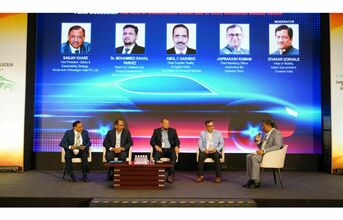
Amol further explained that each OEM has its own technology roadmap, extending beyond short-term plans. The key challenge is to collaboratively identify opportunities to integrate solutions from tier one, tier two, and tier three suppliers. While OEMs may not readily share this information, presenting innovative products and demonstrating their alignment with the OEM's goals can open doors for collaboration.
Speaking on behalf of Varroc, Parvaiz stated that the company is consistently on the lookout for opportunities. They actively seek areas where they can introduce changes. The process involves continuous effort, including prototyping, and approaching OEMs with proposals for material changes that can offer benefits.
The process begins with input from established raw material suppliers, followed by collaboration with compounders who work based on the company's requirements. The challenge then becomes adapting the design from conventional materials to the new material, conducting validation and testing, and presenting the final product to OEMs, ensuring it meets their specifications. While there may be challenges in obtaining precise requirements initially, once there is clarity and focus, the company is able to learn and develop formulations according to current needs.
He also called out for collective action, stating that it's not about setting individual targets; it's a collective objective for everyone.
Gokhale then sparked a conversation on the vehicle scrappage policy, to which Amol replied that Tata Motors has already opened two scrappage facilities, one in the north and one in the south or eastern zone, and there are many more scrappage facilities that can be expected from the company as it aims to build a pan-India presence. Further, these scrap centres will process commercial vehicles of all brands, and this is how we are supporting a circular economy.
While concluding, Divakar posed a critical question to the panellists and raised a response about whether consumers are aware of the use of sustainable materials in vehicles, and while purchasing a car, they started asking about whether it contains any sustainable materials.
Only when the thought process moves beyond the mileage that a vehicle provides, or as Sanjay quoted, "kitna deti hai," will people be able to think about this.
He envisioned that the Gen Z coming forth will be more conscious about these topics.
Gaikwad articulated that for consumer awareness to spread, the market is not mature enough. Though India is seeing considerable growth when it comes to the volumes of passenger and commercial vehicles, with respect to the average price point, the country is not quite on par with developed nations.
Parvaiz added that, in his view, the primary focus should be on advertising. He used Ford as an example and pointed out that consumer awareness about sustainability will occur through effective advertising. Once the word is spread, considering the changing purchasing power of consumers, people will start discussing and inquiring about the sustainable contents of their vehicles. With the evolution of electric vehicles, there is significant potential, particularly in replacing internal components like cockpits or luggage with sustainable materials. Consequently, OEMs will eventually be able to promote cars with, for instance, 20 or 30 percent recycled materials, bringing about a positive change.


























